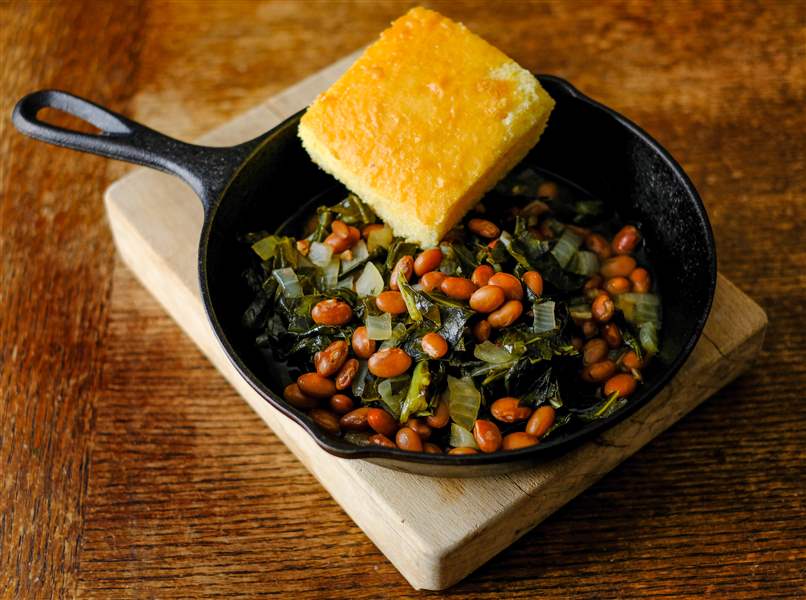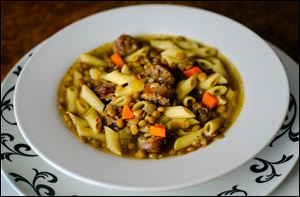
So many ways to say 'Happy New Year' through food
Delicious holiday traditions from around the globe
12/26/2017
Beans, Greens, and Cornbread
THE BLADE/JEREMY WADSWORTH
Buy This Image
We will soon be saying goodbye to 2017.
In honor of the occasion, many will raise a glass of champagne to toast 2018. And there are a wide variety of traditional foods eaten around the world, as well, in hopes of inviting good luck, prosperity, long life, and bountiful blessings in the new year.
In Greece, a special treat called vasilopita, which has a hidden coin tucked inside, is shared on Jan. 1 — a saint’s feast day in addition to being the first day of the year. “It’s a special bread or cake made as a tradition associated with St. Basil's Day,” said Kathy Lawrence, a member of Holy Trinity Greek Orthodox Cathedral.
The vasilopita is sliced, Mrs. Lawrence said, and “[each] family member and guest gets a piece. The person who gets the coin will have good luck in the coming year.” According to the church’s cookbook, Olives, Feta, Phyllo and More (Mrs. Lawrence was deeply involved in the book’s publication), the tradition began in the 4th century when Basil, a bishop, asked women to bake bread with gold tucked into the loaves that could be distributed to the poor.

Beans, Greens, and Cornbread
Norwegian tradition offers either a rice porridge or a creamier pudding in which a blanched almond has been hidden. The one who finds the elusive nut is said to benefit from good fortune in the new year. Another favorite food in northern Europe, and among Midwesterners of Scandinavian and Polish heritage, is to eat pickled herring at the stroke of midnight with hopes that one’s blessings will be as bountiful as the fish are.
People in Spain and in Spanish-influenced communities engage in Las Doce Uvas de la Suerte, the Twelve Grapes of Luck, eating 12 grapes at midnight, one for each toll of the bell as it strikes and for each month of the upcoming year. Additionally, in Mexico and in Latin American, buñuelos — sweetened, fried balls or discs of dough — are eaten as a symbol of good luck.
Hogmanay black bun is a Scottish treat served on New Year’s Eve. (Hogmanay means “last day of the year” in the Scots language.) David Donley of Bowling Green, an expert on Scottish history who participates in re-enactments and is known professionally as Elliot MacFarlane of the St. Andrew's Society of Detroit, said that it is “a raisin-based fruit cake covered with pastry.” Like many “foods coming out of the late Middle Ages and Renaissance,” he said, “it is heavily spiced (preservative and odor hider) and cooked a long time.”
Warm from the oven, black bun “is great to break into; the rich smells of raisin and dark spice fill the room,” Mr. Donley said. “Served with a good single-malt whisky, it can be a meal by itself.” And throwing “the whisky bottle cork into a roaring fire” is another Hogmanay practice, he said, as is the “first footer” tradition: the first person to come to a Scottish home in the new year is expected to bring black bun and whisky and sets the tone for the next 12 months.
Throughout Asia, strands of noodles are prepared as a symbol of longevity. Known as “long life noodles” in China, they are never broken. In Iran, the twisted pasta represents the multitude of possibilities for one's life; untangling them brings good luck in the new year.
Pork is popular in Germany, Hungary, and other central European countries — and among those in the Midwest whose ancestors emigrated from that region — because of the luxurious richness and fattiness of the meat, which will have been butchered on farms shortly before the new year celebrations. Pigs rout in the dirt in a forward fashion, too, which is symbolic of looking ahead into the future.
Sweet foods are served at Rosh Hashanah, the Jewish new year, and are equally appropriate for the secular celebration. Honey cakes and sliced carrots, which resemble coins, are offered, as are foods with plentiful seeds (sesame, poppy, pomegranate, etc.), symbolizing fruitfulness.
In Italy, brown or green lentils are prepared at the holiday because they resemble coins and allude to aspirations for wealth in the new year. They are usually served with pork sausages.
Pretzels are eaten in Germany, a practice that has continued among the descendants of German immigrants in the Sandusky area.

Pasta, Lentil, and Sausage Soup
At the turn of the 20th century, bakeries in northern Ohio started preparing a unique variation on the twisted breads that were meant to be eaten first thing on Jan. 1. According to a summary provided by the New Years Pretzel Facebook group, filled with devotees and featuring recipes: “It is soft and made from an egg dough, and instead of being sprinkled with salt, it is washed with a glaze. The finished product is chewy.” The size can range from just over a foot to as many as 3 feet across. Blade Photo Editor Lisa Dutton-McCord is a part of that history: her father’s grandfather, Charles Knoerle, “started a bakery in Sandusky and they made and sold pretzels [for] years,” she said of the now-closed Knoerle's Pure Food Bakery and its beloved treats that were baked ’round the clock for the holiday. A few professionals and some home bakers still make the twists.
And finally, Hoppin’ John, a dish of black-eyed peas and rice, is eaten in the southern United States — and enjoyed by many who have ties to the South — for good luck at the new year. A variation on this is Beans, Greens, and Cornbread, in which coppery-colored pinto beans represent coins, collard greens are symbolic of paper money, and the yellow bread is reminiscent of gold in a plate full of hopes for good financial fortune.
And so, as January approaches, we wish you bonne année. Felice anno nuovo. Godt nytt år. Szczęśliwego nowego roku. Bliadhna mhath ùr. Ein gutes neues jahr. Feliz año nuevo.
And, of course, a very happy new year.
Norwegian Rice Pudding
3½ cups water
Pinch of salt
1½ cups Arborio rice
1 cup half-and-half
2 teaspoons vanilla extract, divided
¼ teaspoon almond extract
1 cup whipping cream
¼ cup powdered sugar
¼ cup sugar
1 blanched almond
Lingonberry or raspberry jam, for serving
In a 3-quart saucepan, bring the water and salt to boil and add rice. Cover, lower heat to simmer, and cook 20 minutes until the water is mostly absorbed.
Combine the half-and-half, 1 teaspoon vanilla extract, and almond extract; add to the rice, cover, and cook 10 minutes until most of the liquid has been absorbed and the rice is creamy. Pour into a bowl, cover with plastic wrap pressed to the rice, and refrigerate until cold.
Before serving, whip the cream with the powdered sugar, the sugar, and the remaining 1 teaspoon vanilla extract. Fold the cream into the rice along with the almond, which should not be visible. Divide among serving cups and top with jam.
Yield: 12 servings
Source: Adapted from thornews.com
Pasta, Lentil, and Sausage Soup
1½ cups brown or green lentils, soaked for 12 hours, drained
Olive oil
4 Italian pork sausages, hot or mild
1 onion, diced
1 carrot, diced
2 stalks celery, diced
2 bay leaves
4 cups chicken or vegetable broth
1/2 cup white wine
2 tablespoons prepared pesto
Generous pinch of red pepper flakes
Kosher salt, to taste
1 cup small dried pasta (ditali, mini penne, etc.), cooked
Place lentils in a large saucepan, cover with water, and bring to a boil. Cook over medium-low heat for 15 minutes. Skim away any foam that rises to the surface.
In the meantime, heat a few tablespoons olive oil in another large pot and sear the sausages so they are browned all over. Remove sausages and set aside. Turn the heat to low and cook the chopped onion, carrot, and celery until the onion is translucent, about 10 to 15 minutes, stirring occasionally.
Slice the seared sausages; add them to the pot along with the bay leaves, lentils, the broth, the wine, the pesto, and the red pepper flakes. Bring to a boil and cook, covered, over medium-low heat for 30 minutes or until lentils are tender. Taste for salt and season accordingly.
Add pasta to the pot and heat through; cook for a few more minutes, uncovered, until thickened to desired consistency. Serve with a little extra virgin olive oil drizzled over the top.
Yield: 6 servings
Source: Adapted from Rosemarie Scavo, italymagazine.com
Beans, Greens, and Cornbread
2 pounds collard greens
3 bacon strips, chopped
1 small onion, chopped
2 garlic cloves, minced
2½ cups water or vegetable stock
2 tablespoons brown sugar
1 tablespoon cider vinegar
¾ teaspoon salt
½ teaspoon pepper
Generous splashes of hot pepper sauce
1 15-ounce can pinto beans, rinsed and drained
Cornbread, for serving
Remove and discard center ribs and stems from collard greens. Cut leaves into 1-inch pieces.
In a Dutch oven, cook bacon over medium heat until crisp, stirring occasionally. Add onion and garlic to bacon and drippings; cook and stir 2 minutes. Add collard greens; cook and stir until they begin to wilt. Stir in water or stock, brown sugar, vinegar, salt, pepper, and hot pepper sauce; bring to a boil. Reduce heat and simmer, covered, 55 to 65 minutes or until greens are tender. Add beans during the last 15 minutes.
Serve with cornbread.
Yield: 8 servings
Source: April Burroughs, tasteofhome.com
Contact Mary Bilyeu at 419-724-6155 or mbilyeu@theblade.com, and follow her at facebook.com/thebladefoodpage.